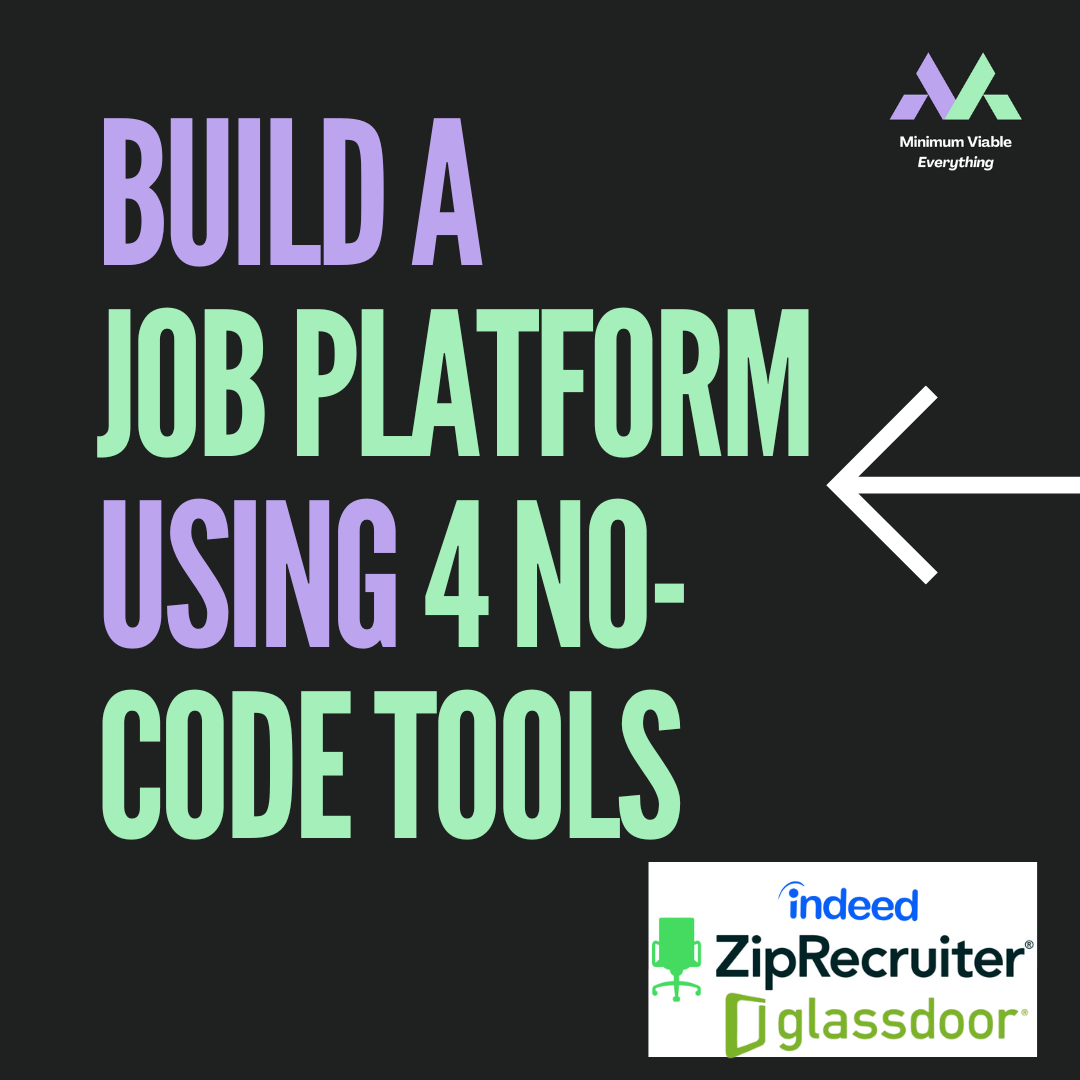Building Job Listing Platform with No-Code
Written on December 24th, 2024 by Harman
Building a Job Board Platform Using No-Code Tools
Introduction
This guide will walk you through creating a fully functional job board using no-code tools, perfect for testing your market before investing in custom development.
Want to learn more about building successful products with no-code tools? Subscribe to Minimum Viable Everything, your weekly guide to rapid prototyping and product validation. Each week, we break down another innovative product, showing you exactly how to build it using no-code tools.
Subscribe now to join thousands of entrepreneurs learning how to rapid prototype their ideas. Back to the guide now!
Core Product Features
Our job board will include these essential features:
- Job posting submission and management
- Job seeker profile creation and management
- Search and filtering functionality
- Automated email notifications
- Basic analytics and reporting
- Payment processing for job postings
Primary Tool Selection
We’ll use Bubble.io as our main platform, complemented by specific tools for enhanced functionality:
- Bubble.io - Main application platform. Bubble templates.
- Airtable - Database and content management. Airtable API Reference.
- Mailchimp - Email marketing and notifications. Mailchip CRM
- Stripe - Payment processing. Stripe Connect Guide.
Step-by-Step Implementation
Phase 1: Setting Up the Foundation (Estimated time: 4-6 hours)
Begin by creating a new project in Bubble.io and establishing your data structure:
- Create your database structure in Bubble:
- Jobs: title, description, company, location, salary, requirements, post date, expiry date, status
- Companies: name, description, logo, website, contact information
- Users: email, name, resume, job preferences, application history
- Design your main pages:
- Homepage with featured jobs
- Job listing page with search/filter
- Individual job posting page
- Company profile page
- User dashboard
- Admin dashboard
Phase 2: Building Core Functionality (Estimated time: 8-10 hours)
Job Posting Workflow
- Create the job submission form:
```
Workflow in Bubble:
- Create a new page: “Post a Job”
- Add input fields for all job details
- Set up “Submit” button workflow:
- Create new “Job” entry
- Upload company logo to “Images” storage
- Redirect to payment page ```
- Implement search functionality:
```
Search Configuration:
- Create search input group
- Set up dynamic filtering:
- Location (text match)
- Salary range (number range)
- Job type (exact match)
- Keywords (contains) ```
Phase 3: Integration Implementation (Estimated time: 6-8 hours)
Payment Processing with Stripe
- Connect Stripe in Bubble:
- Install Stripe plugin
- Configure webhook endpoints
- Set up product pricing tiers
- Create payment workflow:
```
Payment Flow:
- User submits job posting
- Redirect to payment page
- Process payment through Stripe
- On success: Activate job posting
- Send confirmation email ```
Email Notification System
Set up Mailchimp integration:
Email Workflows:
1. New job alert to matching candidates
2. Application received (to employer)
3. Application confirmation (to candidate)
4. Job posting expiration warning
Common Challenges and Solutions
Challenge 1: Performance with Large Data Sets
Solution: Implement pagination and lazy loading
Bubble Configuration:
- Set page size to 20 items
- Enable "Load more" functionality
- Index frequently searched fields
Challenge 2: Search Response Time
Solution: Optimize search parameters
Search Optimization:
1. Limited initial results
2. Progressive loading
3. Cached recent searches
Success Metrics and Validation
Key Performance Indicators (KPIs)
- User Engagement:
- Time on site
- Search frequency
- Return visits
- Profile completion rate
- Business Metrics:
- Job posting conversion rate
- Revenue per posting
- Monthly recurring revenue
- Customer acquisition cost
Feedback Collection Methods
- Automated feedback surveys:
- Post-submission survey for employers
- Application completion survey for job seekers
- 30-day usage follow-up
- Analytics implementation:
```
Tracking Setup:
- Google Analytics integration
- Custom event tracking
- Conversion funnel monitoring ```
Iterative Improvement Process
- Weekly review cycle:
- Analyze user feedback
- Review usage patterns
- Identify friction points
- Prioritize improvements
- Monthly feature releases:
- Bug fixes
- UI improvements
- New feature rollout
- Performance optimization